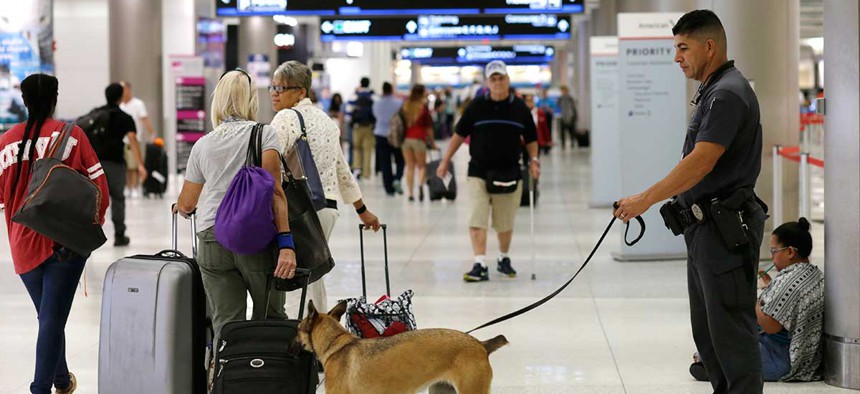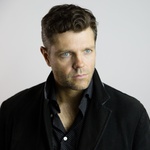
A K-9 handler with the Miami-Dade police department patrols at Miami International Airport Friday. Lynne Sladky/AP
After Istanbul, Here’s How Airport Experts Want to Protect You at the Curbside
The bombing in Turkey show that the U.S. still has a lot of security softspots.
We’ve become so concerned with keeping terrorists off of airplanes that we’ve created an entirely new terrorist target, lines of people waiting to get through airport security.
The Department of Homeland Security, or DHS, and Transportation Security Administration, or TSA, will increase security at some U.S. airports over the July 4 holiday weekend. But the best way DHS could fight this problem for the long term, in addition to more security officers on both sides of the screening line, may be getting more people into advanced screening programs before they even reach the airport — likeTSA PreCheck.
DHS Secretary Jeh Johnson told lawmakers Thursday that airports would see increased security in the days ahead. “Here in the homeland, since Brussels, we have enhanced security … The American public should expect to see, this July 4th weekend, an enhanced security presence at airports, train stations, and other transit centers across the country by TSA and other state and local law enforcement, as well as security personnel generally,” he said.
DHS will be conducting a full check of all passengers and cargo arriving at U.S. airports from Turkey but they have no evidence of a specific threat. “DHS and our partners routinely adapt both seen and unseen security measures in order to counter evolving threats,” the Department said in a statement.
The key is to improve security without contributing to longer lines at airports, which result in angry travelers and crowds on the unsecure side of the checkpoint, exactly the sorts of crowds targeted by the Brussels and Istanbul attackers.
Officials need to to fundamentally rethink airport security, says Sheldon Jacobson, a mathematics professor at the University of Illinois focusing on airport security. “There’s going to be no compromise at checkpoints; we do not need more there. But we need to rethink the entire system of security,” he said. “The terrorist threats have moved away from the planes themselves and have moved into softer targets, which are very, very expensive to protect. What [security services] are now doing is creating more layers of the softer targets.” Adding security before travelers reach the checkpoint line “creates deterrence as well as some opportunity to spot potential threats before they happen.”
In Istanbul, armed guards near the airport entrance helped limit the amount of damage that the terrorists could cause. The terminal features two layers of security with metal detectors for people attempting to enter the departure zone. None of the terrorists were able to bypass all the security layers to get into the most crowded areas of the airport. Guards stationed outside of the airport originally became suspicious of a man they saw wearing a raincoat in the middle of summer. They followed him and saw him meet up with two other men. That’s when the attackers began shooting at the police. “When the terrorists couldn’t pass the regular security system, when they couldn’t pass the scanners, police and security controls, they returned and took their weapons out of their suitcases and opened fire at random at the security check,” Turkish Prime Minister Binali Yildirim said, according to the Associated Press. One of the attackers detonated his device in the arrivals section, a second moved to the departure section and detonated his bomb there. The third detonated his device in the parking lot to catch people fleeing the chaos inside the airport. Although 44 people died, it could have been much worse.
Government Accountability Office investigators said in a May report that TSA needs to increase security around perimeters. Between 2009 and 2015, TSA and the FBI undertook a series of joint vulnerability assessments, or JVAs, at about 20 percent of the nation’s airports, including the 28 largest hubs and about half of the 57 medium sized airports. But many smaller hubs were not tested. “TSA officials stated that they have not conducted JVAs at all airports system-wide because of resource constraints,” according to the report. “While conducting JVAs at all commercial airports may not be feasible given budget and resource constraints, other approaches, such as providing all commercial airports with a self-vulnerability assessment tool, may allow TSAto assess vulnerability at airports system-wide,” according to GAO.
Decreasing pressure on checkpoints inside airports is essential for better security, says Jacobson, that means gathering better intelligence about pilots, air crews, and passengers to move people through security faster. One method the government is considering: snooping on the social media accounts of foreign travelers. This doesn’t necessarily constitute a violation of privacy (if the account is public) but Jacobson doubts the measure would work.
“The irony is that if you make it public that everyone has to reveal something about their Facebook or Twitter page, then what people could do is circumvent it by making two [pages]; one that’s benign,” he said.
Instead, says Jacobson, DHS should move to enroll more people in screening programs where people give data about themselves voluntarily to receive expedited screening at airports, such as Global Entry and TSA PreCheck. That would allow TSA to focus more of its efforts and resources on the people you haven’t vetted. People moving through security faster allows for smaller crowds inside airports, and, thus, less valuable soft targets. You can also create additional security checkpoints throughout the airport without adding to wait times.
TSA was hoping to get 25 million enrolled in PreCheck by 2019, a number roughly reflecting the number of people who travel three times per year or more. So far, about 3 million have enrolled. AU.S. Travel Association survey conducted in March noted that the $85 enrollment fee may be a barrier for about half of the individuals who had heard about the program but who had not yet registered.
By Jacobson’s calculations, TSA could waive the fee for travelers who fly more than three times a year and still not lose any money on the program. “The savings in people and equipment would offset the amount of money that they would not be collecting for the fee. You’ll see many more PreCheck lines and fewer regular lines because you won’t need as many regular lines. That’s the beauty of it.”
NEXT STORY: Juno’s Triumphant Night







